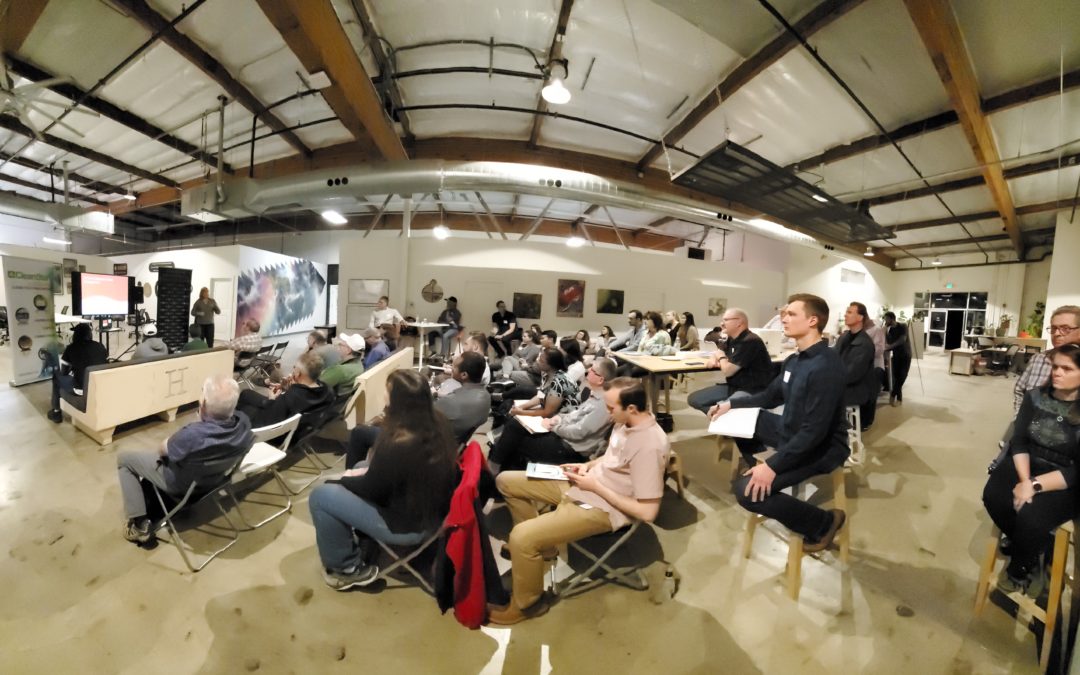At our Feb. 27th MeetUp, 50+ people showed up to hear about novel energy storage concepts and about SMUD’s plans to give incentives to add over 200 MW of storage to its system. But based on the speed with which it was gone, perhaps the biggest hit of the night was the gourmet pizza we had for a snack. Now there’s another reason to come to these MeetUps.
Energy storage is as critical a part of cleantech as renewables. Besides SMUD, we heard from Off the Wall, and Spin Energy.
Jeanne Duvall, Senior Project Manager, presented SMUDs strategic approach to reaching the 246 MW of storage needed by 2030. Currently, SMUD only has 9 MW so the plan is an ambitious combination of partnering with residential and commercial customers. Check out SMUD’s Strategic plan for more details. The StorageShares program Duvall discussed is the rising star secret tool to reduce cost and improve the grid. SMUD’s StorageShare program offers commercial customers the opportunity to invest in offsite storage installations to reduce demand charges. Electrify America invested $1.3 million in SolarShare to offset the demand impact of their Fast Electric Vehicle Chargers.
We then heard from Bob Guimarin, founder and CEO of Off the Wall Energy, who shared with us his small personal portable storage solution. He built his solution around what he found people were demanding. The personal power solution Off the Wall Energy is developing is versatile and acceptable to a larger market. Renters, apartment-dwellers, and small businesses could benefit from it. It is a small, octagonal unit that is easy to move around. IT plugs into any outlet. His device does not feed power back into the grid. It is one way only. But really there is no need to back-feed. It just makes things more complicated.

The one thing that stood out to me was the number of people he had talked to, to discover what they want and what they will pay for. It is an important part of customer discovery and building a successful business. Guimarin was able to adjust his product to what more people wanted but also identify more markets for his solution. In particular, people were concerned about losing power to their WiFi routers. When that goes down, you lose connection to the internet and all the smart devices you may have installed. Not cool. And very annoying. Plug one of his devices into the AC outlet and then connect the router directly.
Off the Wall is the one storage solution we have seen that addresses the rental market, where no tenant wants to invest in a bulky unit that has to be installed on a wall and potentially left behind. He has done some clever electrical engineering to avoid conversion losses as well as providing for connecting his device directly to the DC input on many electronic devices. You know that “brick” you connect to the AC outlet that has the small wire with the funny plug that goes to your TV, computer, wifi, game console, etc.? You don’t need it. Bob’s solution is to connect directly to DC output ports. The capacity of his units now is 440 watt-hours. He sees that increasing to 2000 watt-hours. That’s enough to run a refrigerator for several hours

By the way, check out our Customer discovery workshop on the 17th of March, to sharpen your skills.
We wrapped up with an innovative design of an older storage concept. Peter Cattaneo from SPIN talked about how they are creating an affordable flywheel storage system. They anticipate it will be able to match Lithium Ion but have a life span of 3 times as long. It uses the rotational kinetic energy of a heavy (like 500 lb) flywheel spinning at 20,000 rpm as storage and converts it to electricity by making the flywheel the rotor of a generator with the use of permanent ceramic magnets and with a stator sticking up into the core of the flywheel. When the stored energy is drained down to about 7000 rpm, the generator becomes a motor to spin the unit back up when power is available. They have assembled a team with an impressive history that has tackled the technical obstacles while considering the practically of price. Their goal was to make their device simple and cheap. Part of their clever design is to avoid the use of an actual physical axle. The flywheel spins in a vacuum and is levitated with magnets. While the wheel may distort as it gets up to speed, that only changes the actual center of rotation a bit. With no physical axle, there are none of the problems of trying to use actual bearings to prevent the axle from wobbling when the flywheel distorts. To date, there have been no successful flywheel companies. But Spin may have found the keys to become the first.
With nearly 50 people in attendance, it was quite the event. Several companies were represented along with policymakers, researchers, and students from Sac State and UC Davis. Be sure to stay tuned for our next meetup on Waste-to-Energy on April 30th in Davis with AgStart.
ABOUT THE AUTHOR
Thomas is the Executive Director of CleanStart. Thomas has a strong background in supporting small businesses, leadership, financial management and is proficient in working with nonprofits. He has a BS in Finance and a BA in Economics from California State University, Chico. Thomas has a passion for sustainability and a commitment to supporting non-profits in the region.
Sponsors




Weintraub | Tobin, Revrnt, Moss Adams, PowerSoft.biz, Greenberg Traurig
Follow us on Social Media to keep upto date!


